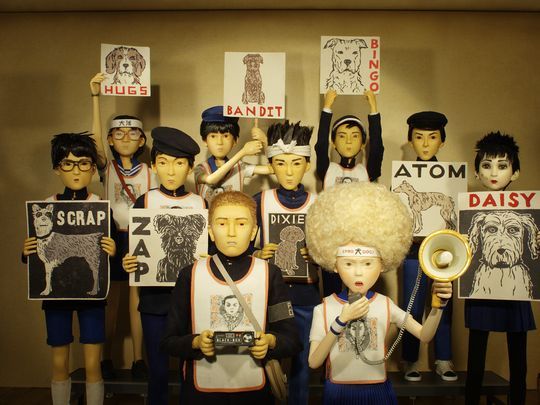by Lynn Lee

A friend on Facebook recently asked me, after I posted a positive response to Isle of Dogs, what I thought about the controversy over Wes Anderson’s alleged cultural appropriation of Japan. My initial answer was that it bothered me a little bit, but not enough to mar my enjoyment of the movie. Later I realized that I’d just implicitly accepted the charge that there was cultural appropriation and, as an Asian American, felt mildly guilty that it didn’t bother me. But on further reflection, I’m not sure either of those knee-jerk reactions was warranted. It’s more complicated than that.
The question of cultural appropriation can be broken down a few different ways...
Does the movie treat Japanese culture respectfully or exoticize it as the “Other”?

These are two distinct, though interrelated, questions. While I’m not Japanese, I would say generally “yes” to the first, if only because the film pays such painstaking visual homage to Japan’s cultural heritage. The production designers modeled its aesthetic from both 1960s Japanese graphic design and Ukiyo-e woodblock prints, while the narrative owes a clear debt of influence to such filmmakers as Miyazaki and Kurosawa. Anderson himself has said that the film is a “reimagining of Japan through my experience of Japanese cinema.” And it’s quite a beautiful one, as even many of the critics have acknowledged.
All well and good, but in trafficking, however playfully, in stereotypes of Japan – cherry blossoms, sumo wrestlers, haikus, sushi chefs, and the like – does the film reinforce the Western sense of Japan, and Asia more generally, as exotic, “oriental,” even a little weird and absurd? Perhaps a little, but I seriously doubt this fantasy version of Japan is likely to mold anyone’s impressions of the real Japan or Japanese people. Anyone adult, that is; parents who want to take their kids to Isle of Dogs might want to provide a supplementary educational disclaimer.
I will say that it does make a big difference that the film—unlike, say, The Darjeeling Express, which also drew criticism for its cultural insensitivities—is animated, and therefore that extra degree removed from any pretense to verisimilitude. This also reflects my broader feelings about Wes Anderson—namely, that he’s at his best when working in animation, and stop-motion animation in particular. His brand of whimsy and exacting, almost fetishistic design translate much more smoothly to an already quaint and highly stylized medium than it does to “live action,” where the result can feel overly precious, artificial, even airless.

Homage or no, should Wes Anderson be (sorry) cherry picking and/or borrowing so heavily from a culture that isn’t his own?
This is a harder one. It’s a fine line between homage and appropriation, and dancing between the two is endemic to filmmaking and art in general. I don’t think even the harshest critics of Wes Anderson are advocating that white artists be prohibited wholesale from coopting imagery or cultural references from non-white cultures. (Or maybe they are, but I don’t subscribe to that view.) But then the only alternative norm would seem to be for the white artist to consult closely with those who do have a valid claim to that cultural legacy and treat that legacy with sensitivity and respect. For the most part, it seems to me that Anderson did that, or tried to. Others may disagree.
Is the movie, despite its foreign backdrop, centered on white characters?
With one exception, no, unless you read the dogs as “white” because they’re voiced in English. (I don’t.) The exception is the character of Tracy Walker (voiced by Greta Gerwig), a young blond American exchange student who foments resistance to Mayor Kobayashi’s campaign to isolate and eventually eliminate dogs from his town. The optics of a white outsider rallying the demoralized non-white opposition against their evil leader are admittedly cringeworthy. Again, though, I see Tracy less as a white colonialist figure than as a clunky attempt by Wes Anderson to improve his track record with female characters, who mainly tend to be pedestaled objects of male pursuit. Alas, he’s not very successful on this front, either. Tracy at first glance has more agency than most women in Wes Anderson movies, but she still ultimately registers as yet another manic pixie dream girl whose main function is to throw the heroism of the main male (human) protagonist into sharper relief. And of course, there’s no particular reason she needed to be white. Maybe the idea was to create a love interest who would be a complete outsider, but there were other ways of accomplishing that.

Readers, what did you think of Isle of Dogs’ use of Japan and Japanese culture? Did you find it delightful or did it leave a bad taste in your mouth?